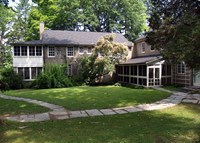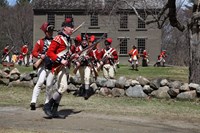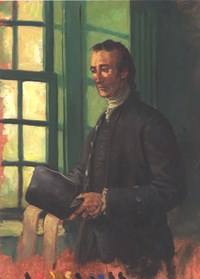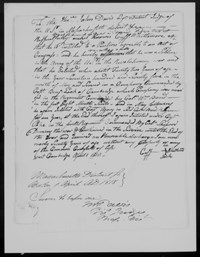- El Camino Real de los Tejas National Historic Trail (43)
- Golden Gate National Recreation Area (28)
- Independence National Historical Park (28)
- El Camino Real de Tierra Adentro National Historic Trail (25)
- Acadia National Park (21)
- Presidio of San Francisco (17)
- Juan Bautista de Anza National Historic Trail (13)
- Tumacácori National Historical Park (11)
- National Mall and Memorial Parks (10)
- Show More ...
- Archeology Program (9)
- Geologic Resources Division (8)
- National Register of Historic Places Program (6)
- National Center for Preservation Technology and Training (5)
- National Heritage Areas Program (5)
- Technical Preservation Services (3)
- Communications (2)
- Harpers Ferry Center (2)
- Inventory and Monitoring Division (2)
- Show More ...
Showing 442 results for DeclarationINDE ...
Independence Hall
- Type: Place

Independence Hall is the birthplace of the United States. In 1776, the Second Continental Congress signed the Declaration of Independence here. Eleven years later, in the same room, delegates to the Constitutional Convention created and signed an enduring framework of government - the United States Constitution.
Pollinator Garden
Thomas Stone
- Type: Article

Fort Des Moines is a military installation in Des Moines, Iowa. During World War I, the fort served as the first and only training site for African American officers. During World War II, Fort Des Moines was the first training site for the Women’s Army Auxiliary Corps (WAAC) and the Women’s Army Corps (WAC), and the only training site for WAC and WAAC officers.
The Sinking of the SMS Cormoran and the First US Shots of World War I
- Type: Article

On December 13, 1914, the German auxiliary cruiser SMS Cormoran, out of fuel and cut off from Germany by World War I, took refuge from Japanese warships in Guam. The ship spent the next two years interned in Apra Harbor. When the United States declared war on Germany in 1917, the Cormoran's captain blew up the ship rather than let her fall into enemy hands.
John Hancock
- Type: Article

From July 1775 through April 1776, General George Washington used the abandoned Vassall House in Cambridge as his military headquarters during the Siege of Boston. In order to organize, administer, and command the army, Washington relied on his council of war, comprised of the senior-ranking general officers, and his "military family," comprised of the staff of secretaries and aides de camp at headquarters.
- Type: Person

A lawyer and influential secretary to George Washington, Robert Harrison helped manage the paperwork and communication for Continental Army during the American Revolutionary War. Despite personal struggles, he left Virginia in the beginning of the war to serve as an aide-de-camp at Washington’s headquarters in Cambridge. Harrison became a trusted and dependable secretary to Washington during the war and went on to become the chief judge of Maryland.
- Type: Place

Edificio Comunidad de Orgullo Gay de Puerto Rico, commonly known as “Casa Orgulllo,” served as the meeting hall for the first official gay/lesbian organization established in Puerto Rico. Founded in 1974, Comunidad de Orgullo Gay was the first organized attempt to confront social, political and legal discrimination against the local LGBTQ community.
Val-Kill
- Type: Place

From a place she called Val-Kill, Eleanor Roosevelt wrote books and newspaper columns, served as the first U.S. delegate to the United Nations, chaired the committee that drafted the Universal Declaration of Human Rights. Val-Kill was a center of her development as activist, humanitarian, diplomat, and one of the most consequential leaders of the twentieth century.
Oldfarm: Station Eight
Home of Daisy and L.C. Bates
- Type: Person

John Laurens, born to a wealthy planter family in South Carolina, received a republican education in Switzerland and England. Upon his return to South Carolina to fight in the American Revolution, he radically proposed to recruit slaves as soldiers in return for their freedom. An aide-de-camp to General Washington and later a lieutenant colonel of the Continental Army with a field command, he served bravely in many key battles, only to die in a meaningless skirmish in 1782.
- Type: Article

Do the inscriptions in the Jefferson Memorial represent Thomas Jefferson's beliefs and philosophies? In this education activity for 8th-12th grade, students will compare an inscription in the memorial to an earlier draft, and to the original text of the Declaration of Independence. They will analyze how shortening or editing a quotation can change its meaning. To extend the lesson, they will compose their own suggestion for an inscription in taken from the Declaration.
A Commemorative Engraving
- Type: Article
William Stone Arrives in the New World
- Type: Article

William Stone came to Virginia from England in 1628. He was appointed as governor of Maryland in 1648 due to his Protestantism. Stone served during a time of religious conflict in the colony, leading to his removal from office, defeat in battle and imprisonment. Upon his release, Stone was awarded property in Charles County, where he built Poynton Manor. Stone's descendants included a Maryland governor, a U.S. Congressman, and a signer of the Declaration of Independence.
Patriots' Weekend 2019
- Type: Article

This year marked the 244th anniversary of the battles of Lexington and Concord, Massachusetts. As the tradition has been since Massachusetts declared the third Monday of the Month as “Patriot’s Day” visitors turn out to experience the offerings in Minute Man National Historical Park as well as area communities which were involved on that day in 1775.
- Type: Article

This guide is intended to help teachers engage students on topics connected to the 250th anniversary of the Declaration of Independence. This commemoration goes beyond studying the document itself. The Declaration outlined values and promises for what kind of country the United States could be. Find lesson plans and other resources to help you talk about themes related to the American Revolution.








